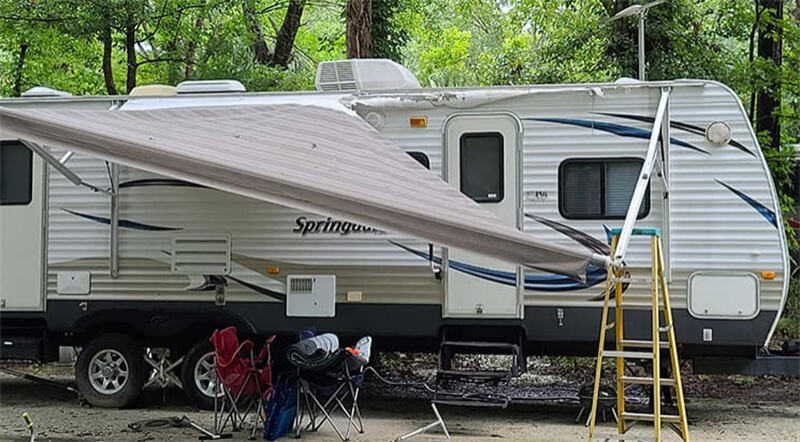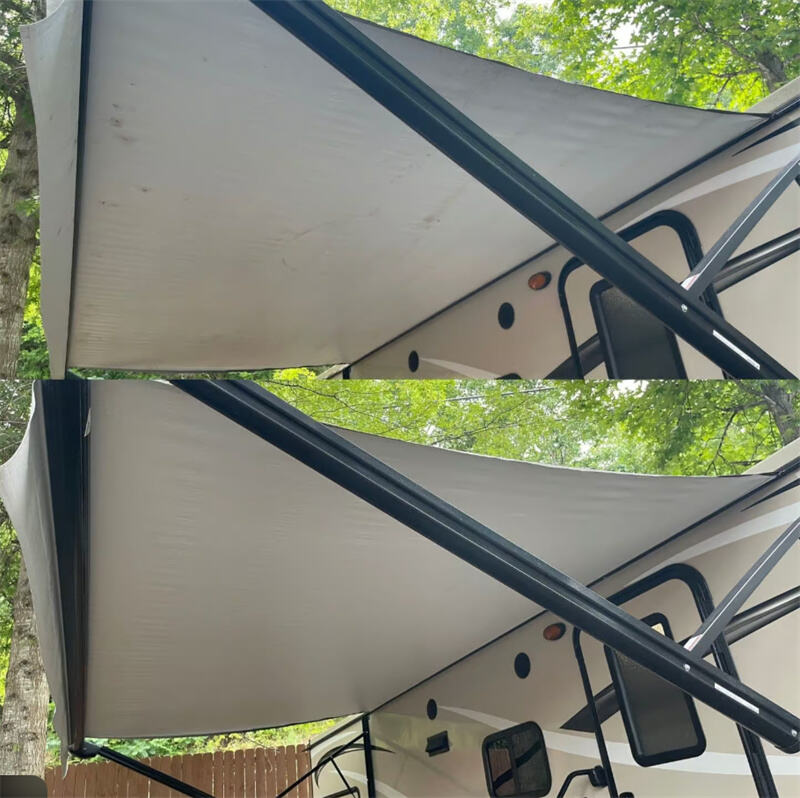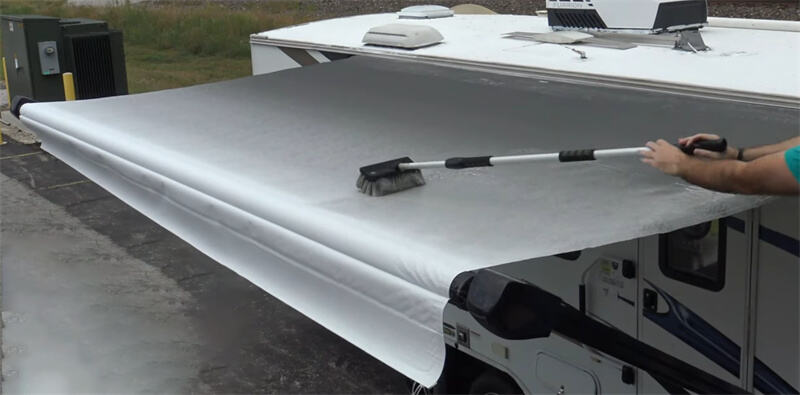RV 여행에서 캐노피는 없어서는 안 될 필수 장비입니다. 캐노피는 뜨거운 햇빛 아래에서 쾌적한 그늘을 제공할 뿐만 아니라 약한 비가 올 때 일시적인 피난처 역할도 하며, RV 생활에 더욱 풍성한 실외 활동의 즐거움을 더해줍니다. 많은 사용자들이 RV 캐노피를 '이동하는 거실'의 연장으로 생각하며, 테이블과 의자, 조명을 설치해 아늑한 휴식 공간을 만들어 냅니다. 그러나 캐노피는 모든 기상 조건에서 안전하게 사용할 수 있는 것은 아닙니다. 강풍이나 폭우 시 제때 회수하지 않으면 단순한 사용 경험 저하를 넘어 모터 손상, 천막 파열은 물론 안전사고로 이어질 수도 있습니다.
I. 위험 분석: 왜 제때 회수해야 할까?
1. 강풍의 위험
강한 바람은 RV 차양에 가장 큰 위협이 됩니다. 차양 천이 펼쳐지면 거대한 돛과 같은 역할을 하게 되며, 강풍을 만나면 금세 위로 들려 올라가게 됩니다. 이때 신축 암(arm)에 가해지는 인장력이 급격히 증가하여 휘어지거나 심지어 파손될 수 있습니다. 바람이 너무 강하면 모터와 고정 구조물도 직접 손상될 수 있습니다. 많은 사용자들이 캠핑 중 갑작스러운 강풍으로 인해 전체 차양 세트를 교체해야 했으며, 이는 높은 비용뿐 아니라 여행 일정에도 차질을 빚게 합니다.

2. 폭우의 위험
강풍에 비해 폭우가 가져오는 숨은 위험은 더 쉽게 간과되기 쉽습니다. 천에 고인 빗물은 처짐을 유발하여 지지대에 가해지는 압력을 증가시킵니다. 제때 제거하지 않으면 천이 찢어질 수 있으며, 심지어 금속 프레임에도 영향을 줄 수 있습니다. 또한, 모터 내부로 빗물이 침투하면 단락이나 녹이 슬 수 있어 RV 캐노피의 수명이 크게 단축될 수 있습니다. 모터가 고장나면 회수하기가 매우 어려워지고, 이후 수리 비용도 증가하게 됩니다.
II. 준비 작업 회수하기 전에 오픈을 사용하는 가장 좋은 점은 바로 이것입니다.
1.C 점검 전원이 꺼져 있는지 확인하십시오 잘 작동함
먼저 RV 차양의 전원 시스템을 점검하여 정상적으로 작동하는지 확인하십시오. 차양이 전기식인 경우 배터리가 완전히 충전되어 있고 배터리 연결부가 느슨하거나 고장 나지 않았는지 확인해야 합니다. 리모컨 방식이라면 리모컨이나 버튼의 반응을 테스트하여 정상적으로 작동하는지 확인하십시오. 배터리 전력이 너무 낮거나 전원 공급에 문제가 있는 경우, 중간에 RV 차양을 닫을 수 없는 상황을 방지하기 위해 먼저 이러한 문제를 해결하는 것이 좋습니다.
2.표면의 습기와 이물질을 제거하세요. RV 차양 천
닫기 전에 천 표면에 고인 물, 얼룩 또는 잔해물이 없는지 확인하십시오. 특히 비 오는 날이나 야외 환경에서는 고인 물이 캐노피에 부담을 주고 정상적인 폐쇄를 방해할 수 있습니다. 깨끗한 천이나 스폰지를 사용하여 RV 캐노피 천의 표면 수분을 제거하고 떨어진 나뭇잎, 가지 등의 잔해물을 제거하십시오. 천에 물이 고여 있는 경우, 캐노피를 말릴 때 젖은 천이 감길 수 있어 곰팡이나 손상을 유발할 수 있으므로 자연스럽게 말린 후 접는 것이 가장 좋습니다.
3. 보장 주변 은 안전합니다
트레일러 선반을 수납할 때 주변이 안전한지 확인하십시오. 먼저 캠핑 테이블 및 의자, 짐, 식물 등의 물건이나 장애물이 선반 주변에 없는지 점검하십시오. 이러한 물건들은 선반을 닫는 과정에서 충돌하여 손상을 일으킬 수 있습니다. 또한 보행자나 반려동물이 주변에 없는지 확인하여 사람이나 물체를 실수로 다치는 일이 없도록 하십시오. 추가적으로, 선반 수납 작동에 영향을 줄 수 있는 RV의 외부 시설물이나 선반 옆에 있는 문 등의 물건이 없는지 반드시 확인해야 합니다.
4.확인 오픈을 사용하는 가장 좋은 점은 바로 이것입니다. 원단 그리고 레일
닫기 전에 선루프 천이 무사하고 손상되지 않았는지 확인해야 하며, 찢어지거나 이물질에 끼워져 있지 않은지 점검해야 합니다. 트레일러 선루프의 원활한 개폐 작동에 지장을 줄 수 있는 먼지나 잔해물이 쌓이지 않았는지 슬라이딩 레일을 꼼꼼히 점검하세요. 레일에 이물질이 끼면 선루프가 고장 나거나 손상될 수 있습니다. 완전히 청소한 후에는 천과 레일이 정상적으로 작동하는 상태인지 반드시 확인하십시오.
위와 같은 사전 준비를 통해 리트랙팅 과정 중 발생할 수 있는 문제들을 효과적으로 방지할 수 있으며, 정상적인 작동을 보장하고 수명을 연장할 수 있습니다. 각 사용 후 이러한 간단한 점검과 준비를 실시하면 야외 캠핑 경험을 더욱 향상시키는 데 도움이 됩니다.
I Ii .올바른 방법 of 리트랙팅
RV로 여행할 때, RV 차양을 신속하고 올바르게 수납하는 것이 매우 중요합니다. 잘못된 조작 방법은 차양에 손상을 줄 뿐만 아니라 여러 가지 문제를 유발할 수 있습니다. 다음은 악천후 상황에서 차양을 올바르게 수납하는 절차입니다.
전기 오픈을 사용하는 가장 좋은 점은 바로 이것입니다. : 전동식 차양을 사용 중이라면, 리모컨이나 버튼 조작 시 일정한 속도로 수납하는 것을 권장하며, 갑작스러운 정지나 급가속은 피해야 합니다. 수납 과정 중에는 차양의 작동 상태를 지속적으로 확인하고, 이상 소리나 걸림 현상이 발생하면 즉시 작동을 중단해야 하며, 원인을 파악하여 해결한 후에야 다시 작동시켜야 모터나 기계 부품의 손상을 방지할 수 있습니다.
수동 RV 차광막: 전동 RV 차광막 모터가 작동하지 않거나 수동 방식을 사용하는 경우, 두 사람이 협력하여 작업하는 것이 가장 좋습니다. 한 사람은 크랭크 핸들을 조작하고 다른 한 사람은 차광막 천의 상태를 확인합니다. 차광막을 회수할 때 천에 주름이나 고르지 않은 부분이 없는지 확인하고, 만약 있다면 끼임으로 인한 천 손상이나 파열을 방지하기 위해 즉시 조정하세요.
위의 팁을 따르면 강풍이나 폭우와 같은 악천후 상황에서도 빠르고 안전하게 차광막을 회수할 수 있을 뿐 아니라, RV 차광막의 수명을 효과적으로 연장시켜 모든 RV 여행을 걱정 없고 안전하게 만들 수 있습니다.
IV. 점검 강풍 후 점검 및 유지보수
폭풍이 지난 후 차광막을 접었다고 해서 모든 것이 정상이라고 가정하지 마세요. 철저한 점검을 통해 잠재적 문제를 조기에 발견하고 향후 손실을 예방할 수 있습니다.
1. 외관 및 구조 점검
타프 점검:
완전히 펼치기: 날씨가 맑을 때 차광막을 완전히 펼치세요.
세심한 점검: 차광막의 앞면과 뒷면을 찢어짐, 구멍, 마모 또는 파열 여부를 점검하세요. 가장자리와 솔기 부분은 특히 주의 깊게 확인하십시오.
곰팡이 점검: 차광막을 완전히 말리지 않은 상태에서 접으면 곰팡이가 생기기 쉬우므로 검은색 또는 녹색 곰팡이 자국이 있는지 확인하십시오.
기계적 점검:
브라켓 및 암: 모든 금속 브라켓과 암에 휨, 변형 또는 균열이 없는지 점검하십시오.
연결 부위: 캐노피와 차량 본체 사이의 연결 부위가 단단히 고정되어 있고 나사가 느슨하지 않은지 확인하십시오.
릴 장치 점검: 리트랙션 또는 전개 시 릴이 원활하게 회전하는지, 이상 소음이나 걸리는 현상이 없는지 확인하십시오.
기능 테스트:
전체 작동: 모터 소리(전동식 모델)를 듣거나 크랭크 핸들 저항감(수동식 모델)을 느끼며 캐노피를 천천히 1~2회 접었다 폈다 하여 정상적으로 작동하는지 확인하십시오.
자동 정지 기능 점검: 전동식 캐노피의 경우 저항을 감지했을 때 자동 정지 기능이 제대로 작동하는지 테스트하십시오.

2. 청소 및 유지
캐노피 청소:
부드러운 브러시와 깨끗한 물을 사용하여 낙엽, 모래, 진흙 등의 이물질을 제거하세요.
잘 지워지지 않는 얼룩은 순한 비눗물이나 전용 천 세척제를 사용하여 부드러운 천으로 부드럽게 닦아주세요. 강산, 강염기, 또는 부식성 세척제는 사용하지 마세요.
곰팡이 또는 누렇게 핀 자국이 있는 경우, 차양 전용 곰팡이 방지 청소제를 사용하세요.
중요: 완전히 말리세요! 청소 후 또는 비가 올 때 차양을 닫은 후에는 다시 접기 전에 차양이 완전히 마를 때까지 기다리세요. 서두르는 경우, 적어도 마른 수건으로 남은 습기를 닦아내고 다음 정류장에 도착하는 즉시 펼쳐서 통풍되도록 하세요.
움직이는 부품 윤활: 록커 암 조인트 및 리일 끝단과 같은 움직이는 부품에 실리콘 기반 윤활제를 뿌려 부드럽게 유지하세요 (차양에 뿌리지 않도록 주의). WD-40과 같은 침투성 윤활제는 장기적인 정비 제품으로 사용하지 마세요. 이러한 제품은 주로 녹 제거용입니다.

3. 장기 유지보수 팁
각 여행 전에 엔트리의 기능과 외관에 대한 정기 점검을 수행하십시오.
정기적으로 철저한 청소와 유지보수를 수행하십시오(예: 분기별).
경미한 손상을 발견할 경우, 추가 손상을 방지하기 위해 전용 엔트리 수리 패치로 즉시 수리하십시오.
스스로 해결할 수 없는 심각한 구조적 손상이나 문제의 경우, 전문 RV 서비스 제공업체에 연락하여 수리하십시오.
V. 요약
강풍과 폭우는 항상 RV 엔트리 사용 시 가장 큰 위협입니다. 제때 회수하지 않으면 차양 천이 찢어질 수 있으며 지지 암과 모터도 손상되기 쉽습니다. 소유자는 나쁜 날씨가 오기 전에 즉시 엔트리를 회수할 뿐만 아니라 정기 점검 및 유지보수 습관을 들여 항상 양호한 상태를 유지해야 합니다. 올바른 사용과 유지보수는 RV 엔트리의 수명을 효과적으로 연장할 수 있을 뿐만 아니라 소홀로 인한 높은 수리 비용을 피할 수 있어, RV 여행을 더욱 안전하고 신뢰성 있게 만들어 줍니다.

 EN
EN
 AR
AR HR
HR CS
CS NL
NL FI
FI FR
FR DE
DE EL
EL HI
HI IT
IT JA
JA KO
KO NO
NO PL
PL PT
PT RO
RO RU
RU ES
ES SV
SV TL
TL ID
ID SR
SR SL
SL UK
UK VI
VI SQ
SQ HU
HU MT
MT TH
TH TR
TR MS
MS AZ
AZ KA
KA LO
LO MN
MN MY
MY KK
KK KY
KY

